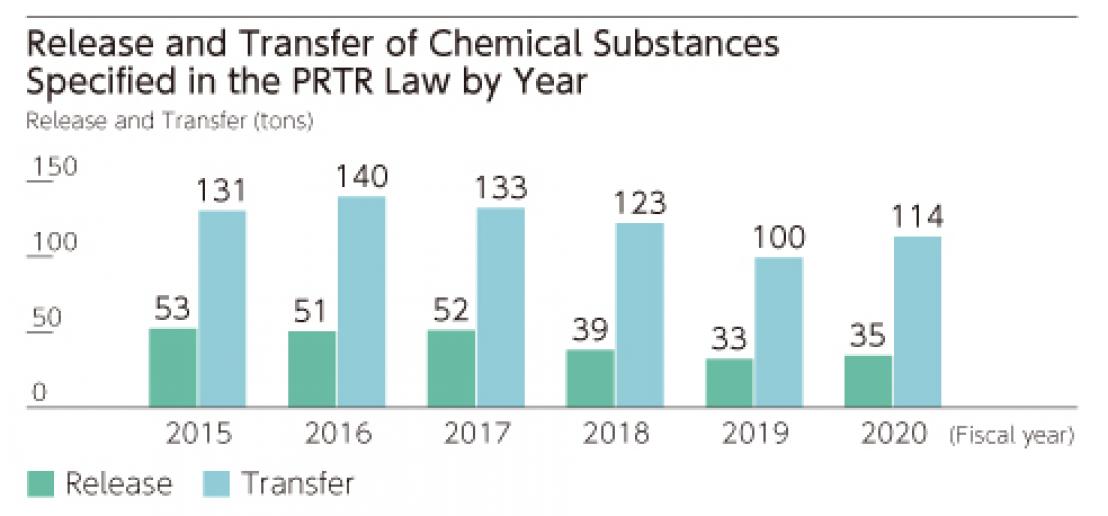Reduction of the Release of Harmful Chemical Substances
We aim to reduce the release of harmful chemical substances and discontinue their use.
The Sumitomo Electric Group is making efforts to reduce the release of harmful chemical substances that cause environmental pollution, including the curtailment of volatile organic compound (VOC) emissions. When we submit reports in accordance with the Pollutant Release and Transfer Register (PRTR) every fiscal year, the PRTR system we have developed is used to identify the amounts of chemical substances that are handled and also calculate the amount of these PRTR-designated substances to be released and transferred. In the meantime, we discontinued the use of chlorofluorocarbon (CFC) substitutes in fiscal 2004. And we discontinued the use of hazardous chlorinated VOCs such as trichloroethylene in fiscal 2011.
Discontinued
Use of
Trichloroethylene, etc.
The entire Sumitomo Electric Group, including overseas affiliates, is committed to discontinuing the use of trichloroethylene and other chlorinated VOCs that are designated as hazardous air pollutants by the Air Pollution Control Law. Consequently, the whole Group, including overseas affiliates, has discontinued the use of chlorinated VOCs in fiscal 2011.
Release and
Transfer of
Chemical
Substances
Specified in the PRTR Law
Sumitomo Electric and its affiliates in Japan, using the chemical substance management system developed by the Company, measure the amount of PRTR substances treated per month, and calculate the amount of these substances released and transferred in order to report annually in accordance with the law.
In the Action ECO-22V Campaign, we are aiming to reduce the absolute amount of the release of chemical substances specified in the PRTR Law by 5% from the fiscal 2017 level.
* PRTR Law
Act on Confirmation, etc. of Release Amounts of Specific Chemical Substances in the Environment and Promotion of Improvements to the Management Thereof

Measures against Dioxins
The aluminum alloy manufacturing facility and its exhaust gas purification facility at Sumitomo Electric Toyama Co., Ltd. are subject to the Law Concerning Special Measures against Dioxins. We have ensured that emissions from these facilities remain within regulated standards.
Measures against Asbestos
The revised Industrial Safety and Health Law prohibits the use of asbestos in products. SEI has already completed measures to switch from asbestos to substitutes and currently produces no product that uses asbestos.
Previously, asbestos was used for electric wires/cables and some accessories requiring fire- and heat-resistance, as well as for disk brake pads, which require resistance to abrasion. In normal use, none of these products pose any risk of asbestos dispersion. However, when a product containing asbestos is crushed or cut during demolition, particles of asbestos may be dispersed. In compliance with the Waste Disposal and Public Cleaning Law, we provide the relevant information to customers receiving delivery of our products that contain asbestos, and the customers dispose of the products in an appropriate manner.
In addition, observing the Asbestos Disorder Prevention Act, which took effect in July 2005, we conducted a group-wide survey of areas in which asbestos is used in buildings. Although we have located the areas in which we should take measures to prevent asbestos dispersion, the results of working environmental measurements have proven that no dispersal has occurred in any of these identified areas. We have promoted and completed measures to remove, seal and enclose the asbestos in the applicable building areas.
Soil and
Groundwater
Remediation
We disclosed the pollution status of three major works (Osaka, Itami and Yokohama) in August 2001. At those three works and other domestic sites where pollution has been identified through our surveys conducted thus far, we are continuing soil and groundwater remediation by soil replacement, groundwater pumping and soil gas absorption. We also conduct groundwater monitoring on a regular basis, and have confirmed that the pollution has not spread outside the sites.
